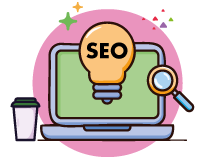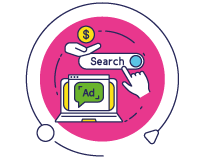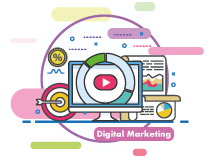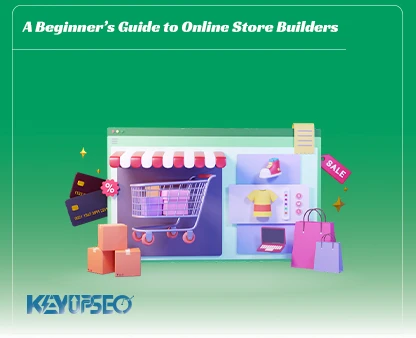
Solutions and examples for gamification in digital marketing
Gamification in digital marketing is defined as the process of adding games or game-like elements to something (such as a task) to increase audience engagement.
In general, gamification is a collection of all fun factors and elements on your website or advertising and sales campaigns so that the audience is better attracted to your services and products.
With a sense of competition, this process creates excitement and gets people excited about your prizes. On the other hand, people are more likely to use a website or app that they have already enjoyed interacting with.
We have provided informative content for marketers in the Keyupseo blog and in the digital marketing section, and today we want to fully explain the solutions and examples for gamification in digital marketing in this article.
The benefits of gamification in digital marketing
Today, gamification is used more in digital marketing. So that it is heavily used in all advertisements. But remember, this is just one marketing strategy you can use in your new marketing plan.
It is interesting to know that this method by itself will not have much effect.
Of course, if used alongside other solutions (such as Web Push, web tracking, content localization, etc.), this method may generate significant profit.
Benefits of gamification
- Gamification develops the following:
- Average session time of the website
- Average time spent reading email
- Email OR, CTR and RPME.
- Audience interaction.
- Social sharing.
- It makes the user experience more enjoyable and more satisfied. A visitor who enjoys browsing your website is more likely to recommend it to their friends.
A user who had fun reading your previous email is more likely to open the next one.
- It is very simple and hassle-free to entertain people through email.
A simple quiz or challenge to find a hidden link can be implemented into a basic email template. Posting on social media with a crossword requires even less effort.
- It helps to collect customer information. Gamification uses various options to entice people to provide personal information (contacts, product preferences) in exchange for rewards (points, rewards, starts, achievements, badges, percentage off, etc.).
When something is given in return for providing personal information, people are more likely to share their data immediately.
- Generates content for email by itself. This feature is especially good for brands that:
- They do not have a blog and do not send their newsletters on the blog.
- They have products and services that are rarely updated.
- They often have sales.
- Can't send personalized recommendations due to lack of customer information.
Basic principles of gamification
Now, to use this method, you must know the basic principles of gamification.
1- Achievable task
One of the main principles of gamification in digital marketing is things like contests, wheel of chance, puzzles and how to work with them. The task you propose to solve should not be too complex for people to solve and reject.
2- Specific goal
Rules and regulations should be simple and understandable for everyone. If the challenge is complex and takes a long time, people will give up and leave without completing it.
3- Attractive design
Every gamification element you use must have a distinctive design and be different from similar solutions from competitors.
For example, when using a website quiz, use questions with relevant images or GIFs. People understand short text better when they encounter some dynamic elements.
4- Fun process
Nobody likes boring games. Of course, people spend their time because they are motivated to finish, but the game plan should also be fun.
5- Reward
Don't unlock the main prize, it will kill the excitement of your game. However, people need to know that there is something for them in the end.
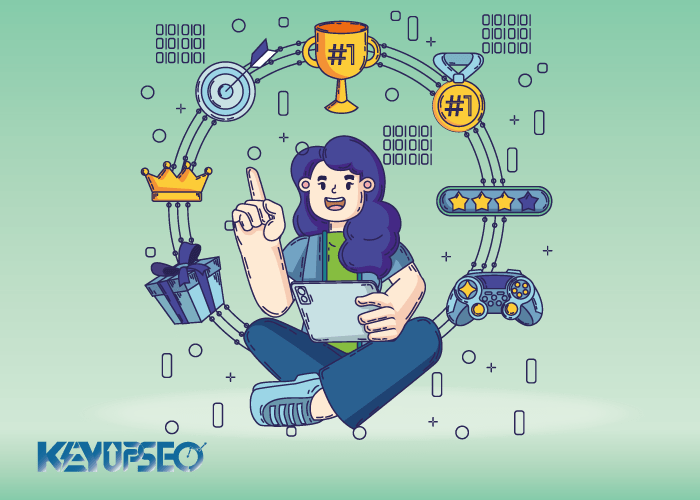
Examples of gamification on the site
It is impossible to talk about gamification in digital marketing without mentioning the site. This process brings a lot of potential to make traditional platforms (often including websites) fun and exciting.
Rewards for doing certain tasks, progress bars, badges and virtual rewards, quizzes, competitions, etc.
Game-like solutions vary depending on the type of business you're in, but below, we've selected and brought you sample options that can be tailored for each industry:
Wheel of chance is a fun element of gamification
Wheel of Fortune is a fun element that gives visitors a chance to win a small gift and popularizes your brand among customers.
On the other hand, with this work, it will be possible to collect customer information (name, address, email, sometimes phone number) and encourage the first purchase at the same time.
The main reason for the success of the wheel of fortune is that losing in it has no meaning.
This one needs no explanation and anyone can play it multiple times. On the other hand, there are not many ways to fail.
Wherever the wheel stops, you'll get a prize or a chance to try again. Plus, it provides a sense of accomplishment.
Clicking doesn't require much effort, but the result will make you feel like you've achieved something important. And the reward for success gives it more weight.
Create a contest
Contests are another element of gamification that helps you communicate and learn more about customer preferences.
This entertainment can be a pop-up, appearing on specific landing pages, or placed above the main website page to encourage visitors to interact with the brand in a more dynamic way.
"Which socks are you interested in today? ", "Find your perfect look", "What kind of dessert are you? ” etc. From personal style finders to quirks, quizzes can be a useful tool for gathering leads from customers.
The quiz is made up of simple questions and comes with supporting images.
It is easy to work with, visually appealing and very useful for people looking for the right hair care products.
Signs
A badge system is a great way to build customer loyalty: a badge can be a nice reward for using a product over a long period of time and taking it through different stages.
Unlocking new locks and collecting new loot is always exciting, so customers love this way of interacting.
Badges are often beautifully designed and fun to collect. It is one of the most popular gamification techniques in digital marketing.
They can bring interesting vibrancy to industries rarely associated with entertainment, for example, education or banking and payment systems.
Offering rewards for step-by-step completion of a specific process helps retain customers and build an engaged audience.
Custom DIY
To introduce visitors to a wide range of products in attractive ways, many brands offer customization options: create a custom look or make-up, room interior, instructions, etc.
Such an approach adds an interactive game simulation to the product display, simultaneously tracking customer preferences: products, colors, ingredients, size, etc.
This data can be used more to create targeted emails and site ads, which is an important principle in the development of any business.
If you still do not understand the importance of advertising, it is better to read the article 10 reasons to advertise.
Examples of gamification in social media
Social networks were probably the first platform to use gamification extensively in their content.
The reason for this is the more flexible system of interaction with the audience on this platform, which is based on immediate response.
You don't need to do A/B testing or complicated research to see which post might be the most successful: likes, shares, and comments will instantly give you all the stats you need.
Additionally, social media publications don't require a lot of technical skills or coding knowledge: a catchy short text, a nice banner or a well-designed image is enough to create a high-yielding post.
Many companies have started using gamification years ago, and some marketing campaigns have become cases for gamification case studies.
I SPY
A seemingly childish game that attracted more than 25 thousand viewers and became popular among them.
This success means that people spent their time looking for a small pretzel among hundreds of candies, and this is the success of gamification.
The reason for the success of this game may be that it reminded people of their childhood and similar activities they had with their friends.
The M&M chocolate company also likes this game and offers its audience to experience it.
find the differences
Honey Baked Ham Company is a prime example of companies that like to use gamification mechanics for their Facebook posts.
By scrolling through their newsfeed, you will see different gaming opportunities.
Although we intend to introduce Spot the Differences in this section; Find the wrong answer, the Family Food game, name the holiday song, choose a weekday meal, and more are some of the other fun on this page.
Incidentally, this company is one of the earliest adapters of gamification: the oldest post we found was from 2014.
In fact, the possibilities of adding a gaming element to social media are vast, and your imagination is the only limit.
Other such games include:
- Crossword puzzle
- Hallucinogenic images
- unimportant things
- Spiral
- Mystery

Examples of content gamification in emails
Gamification in email digital marketing is not new either, but it is not as widely used as other email practices such as the use of animations, countdown timers, user-generated content, etc.
This is because gamification requires more of a designer or developer to execute properly.
Additionally, there is no set pattern that you can use consistently. Gamification is based on anticipation and excitement, so you always have to come up with new ideas to keep people interested.
But with the competition for customer attention increasing day by day, brands need to find new ways to promote products and engage with customers, and gamification can help.
To see what gamification looks like in action, let's take a look at examples of gamification that major businesses have implemented in their email marketing campaigns:
- Game selection between options
- Various competitions
- Right and wrong
- Find your type of game
- Play, find the original gift
- Wheel of Fortune
- voting
- unimportant things
- Virtual board games
You can also find a few emails with gamification elements in your inbox, and the number will only grow when brands decide to go all out, according to customer preferences.
Additionally, the recently introduced AMP technology can provide new ways to use gamification in business.
Because this feature allows interaction with content directly in the body of the email, a user can solve dynamic quizzes or ad tables in a specific campaign and instantly get rewarded in the same email window without loading additional pages.
This helps reduce routing losses between page transactions.
Gamification in digital marketing and its effect on audience attraction
Ultimately, the goal of any marketing is to encourage signups, subscriptions, purchases, feedback, etc. Gamification is a solution that can help achieve these factors by creating more fun and dynamism in user interaction with content.
Gamification in digital marketing can attract attention and, most importantly, engage people, encourage them to share personal data and have a longer conversation with the brand, and contribute to the loyalty of the brand's audience community.
Thanks to the variety and abundance of formats, gamification can be used on different platforms, website, app, social media, physical store, events and email.
Depending on the type of business and available channels, brands can create targeted gamification strategies to make their digital marketing work better.
There are no guidelines and no limits to your creativity and imagination, the only guidelines to follow are your client's preferences.
Release date : 24 August, 2023






